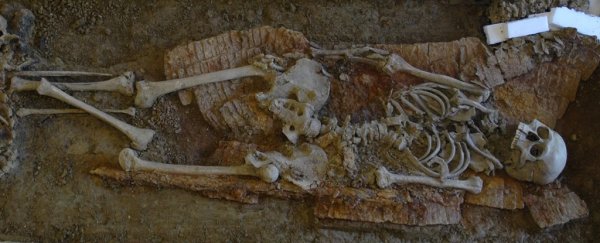When Rome fell, Europe churned. Cultures from far and wide – the Huns, the Goths, the Vandals – violently etched their names into history before being crushed by fresh waves of invaders.
Among them were less infamous bloodlines with far more mysterious origins. Like, for instance, the formidable mounted warriors known as the Avars.
The horde of horseback fighters emerged from the east in either 567 or 568 CE, pushing out the various Germanic groups from the Carpathian basin in Europe's southeast.
There they remained for more than 200 years before falling to the Franks at the end of the 8th century.
Much of what we know of them comes from Byzantine texts – records which could well be biased by fear or hate. There were even bold claims that they weren't even true Avars, hinting at a legacy stolen from a people far to the east.
A new genomic analysis of the remains of 66 individuals uncovered from a diverse spread of Avar graves now reveals they were in fact the descendants of a Central Asian culture far to the east, providing the first solid evidence of a migration that would have taken place in record time.
"They covered more than 5,000 kilometers [3,100 miles] in a few years from Mongolia to the Caucasus, and after 10 more years settled in what is now Hungary," says Seoul National University population geneticist Choongwon Jeong.
"This is the fastest long-distance migration in human history that we can reconstruct up to this point."
Combined with historical accounts, the genetic evidence confirms the birthplace of the Avars was the Rouran: the first confederation of early Mongol tribes ruled by a khan.
Established in the late 4th century, the early khaganate fell just over a century and a half later to rival bands of Asian Turks, sparking the rise of Turkish power in the east.
Just 15 years after the group's collapse, diplomats from the Roman city of Byzantium recorded that a people who called themselves the Avars had taken refuge from Turkish hostilities half a world away, settling in the Carpathian basin.
The Avars would make their presence known, engaging in a series of offensives far across the land that would eventually culminate in a joint siege of the Byzantine capital of Constantinople.
Around this time an Egyptian-born Byzantine historian by the name of Theophylact Simocatta argued these adept warriors might not be who they claim to be, and could – in fact – be of a mixed heritage made up of lineages much closer to home.
"In point of fact even up to our present times the Pseudo-Avars (for it is more correct to refer to them thus) are divided in their ancestry, some bearing the time-honored name of Var while others are called Chunni," the historian wrote.
While we know much of their affairs from their enemies, the Carpathian branch of Avars left no written records themselves.
They did leave a detailed archaeological record, though. Hundreds of settlements containing around a hundred thousand burials have been analyzed by researchers throughout the decades, providing troves of data on how they lived, died, and fought.
We know how their society was culturally diverse, reinforced by captives brought in from around the Balkans who provided labor and knowledge.
Now that their bones can speak, their true past is known as well.
Of course, history is rarely so clean cut. There's little doubt that a population of riders fled central Asia at speed, covering scores, if not hundreds of kilometers each year to put distance between them and their Turkish attackers.
But once established in their new home, it seems the Avars continued to weave new bloodlines into their fold.
Lead author of the new study, Guido Gnecchi-Ruscone, a geneticist from the Max Planck Institute for the Science of Human History, explains how his team uncovered evidence of cultural diversity arising among the invaders.
"Besides their clear affinity to Northeast Asia and their likely origin due to the fall of the Rouran Empire, we also see that the 7th-century Avar period elites show 20 to 30 percent of additional non-local ancestry, likely associated with the North Caucasus and the Western Asian Steppe, which could suggest further migration from the Steppe after their arrival in the 6th century," says Gnecchi-Ruscone.
The genetics don't go so far as to link in cultural data or provide a timeline, but they nonetheless help reinforce a story of a perpetuated elite descended from a long lost Mongolian khaganate half a world away.
As the 8th century drew to a close, the Avar threat was no more.
Failing to negotiate with the forces of the Carolingian monarch Charlemagne, the once ferocious Mongolian equestrians turned and fled once again, their famous bloodline fading into Europe's darkness as quickly as it arrived.
This research was published in Cell.
